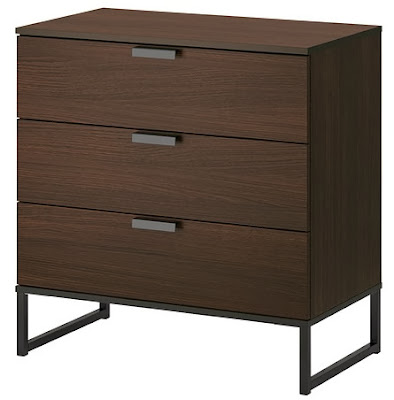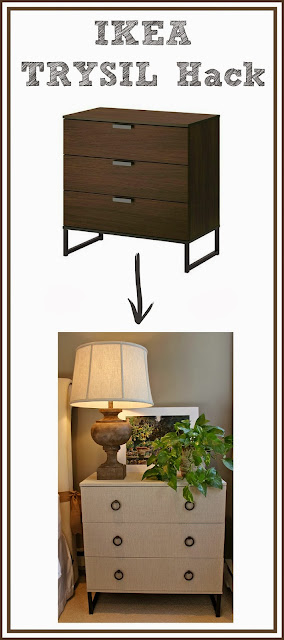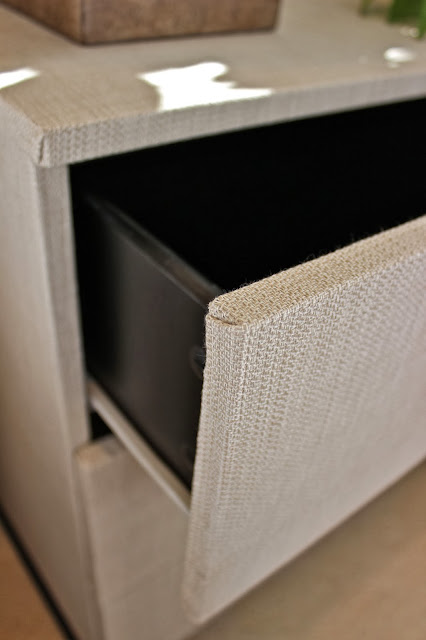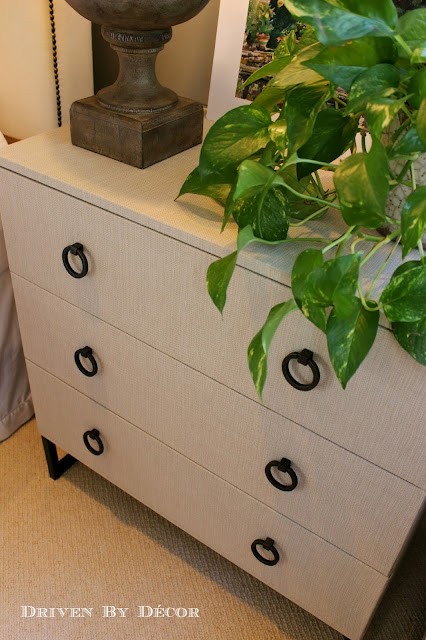First off, I want to give you all a huge thanks for the sweet comments on my guest room makeover. You sure know how to make a girl feel good 🙂 My favorite part of our new guest room is the DIY chest that sits to the right of the bed.

Would you believe that it started out looking like this?





Next, you’ll want to get all of the pieces of the TRYSIL chest out of the box and read through the assembly instructions to figure out which piece is which. Put a small piece of painter’s tape on the side of each piece that will be on the inside once the chest is assembled. Write the name of the piece (side, top, drawer front, etc.) on the tape.
Measure the drawer fronts and the sides, top, and bottom of the chest and add about 6-8″ to the each of your dimensions (there will be some fraying of the edges of the fabric so you need this extra amount to allow for that – you can cut off excess later if needed). Cut out pieces of fabric in those sizes. One tablecloth is enough fabric for all of the pieces that you’ll need to cover the chest as long as you lay it out in a way that you’re not wasting lots of fabric. Do not use the hemmed edges of the tablecloth – cut off and discard those.

Next step? Iron. Steam iron the heck out of your fabric to get out the fold marks and wrinkles.
The last step before adhering the fabric to your pieces is to prep the drawer fronts. Each drawer front comes with two predrilled holes for the handles. Fill these two holes with wood filler, wax, or putty. I used a Minwax pencil:

Then figure out where you want your new pulls and drill the holes for them. It helps to use painter’s tape to mark the spot that you’re drilling the holes and to keep the laminate of the wood from flaking off the surface when you drill them.

You’re now ready to put your fabric on the fronts of your pieces. I originally tried Mod Podge but I quickly saw that it soaked through portions of the fabric and darkened its color so for plan B I used {this Super 77 Adhesive Spray}, which worked great. This stuff is SUPER sticky and a little goes a long way. You need to use it in a well ventilated area so I spread a big dropcloth out in the garage (with the garage door open) and did it there. The process is pretty simple. For each piece, spray a light coat of adhesive spray on the side of the piece that will be on the outside of the chest and then gently lay your fabric piece on top of it. Readjust the piece to align it properly by lifting it up and placing it back down as needed. Once your fabric piece is centered on the wood piece, press it down onto the wood piece and smooth out any wrinkles.

Now you need to wrap the fabric around the edges. Instead of trying to spray the edges, I found it was easiest to spray some of the adhesive spray on a paper plate and then use a small paintbrush to spread it on the edges. Doing it this way also keeps you from getting too much glue on the fabric. The glue on the plate and the wood piece dries very fast, so you have to keep spraying more on the plate and keep wrapping and pressing the fabric down on the edges as you go.







Then insert the screw for your pull through the hole in the drawer and through the opening in the fabric that you made with the skewer. Turn the pull (NOT the screw) to tighten it onto the drawer front. Turning the screw can pull at the fabric and create a run in it (yep, unfortunately I learned that the hard way…).
I wanted the legs of the chest to match my hardware so before attaching them to the chest, I sprayed them with {this Rustoleum Paint & Primer}:

Done!



So what do you think? If you have any questions, shoot me an email or leave a comment. Enjoy the weekend!





